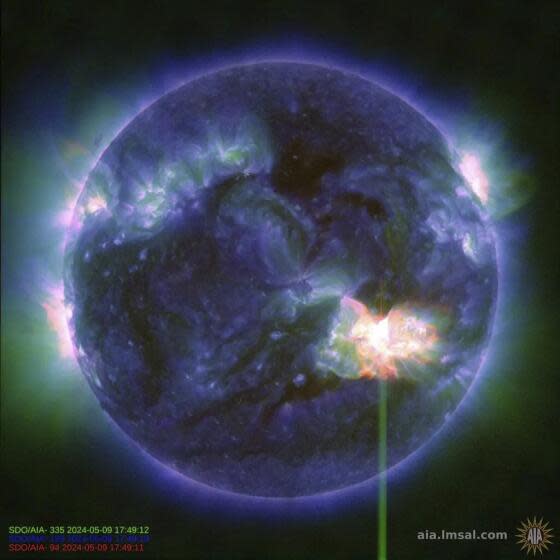Solar storm heading to Earth could disrupt communications and bring northern lights to California

A different kind of storm could complicate this weekend’s plans.
For the first time since January 2005, the U.S. National Oceanic and Atmospheric Administration has issued a severe geomagnetic storm watch for Friday evening.
The category G4 watch from NOAA’s Space Weather Prediction Center signals the possibility that a concentration of energy flaring from the sun could disturb our planet’s electromagnetic field once it reaches Earth.
A geomagnetic storm of this size could disrupt communications, like the 2003 event that caused blackouts in Sweden and damaged South Africa’s power grid.
More promisingly, super-charged collisions of solar energy into the gas of our atmosphere creates the dazzling phenomena of aurora borealis, or the northern lights. Typically confined to polar regions, the colorful display could be visible this weekend as far south as Northern California.
“We have a very rare event on our hands,” space weather forecaster Shawn Dahl of SWPC said during a news conference Friday morning.
Read more: After months of silence, Voyager 1 has returned NASA's calls
A geomagnetic storm happens when energy from solar wind — the high-speed current of atomic particles the sun is constantly flinging into space — is transferred into the electromagnetic field that surrounds Earth.
The winds of a Category 5 hurricane on our puny little planet can exceed 150 miles per hour. In contrast, solar wind averages about 870,000 miles per hour all day, every day according to NASA.
Earth’s electromagnetic field deflects the majority of these particles, save for those interactions in the polar areas that produce the northern lights. But unusually intense or concentrated eruptions of energy on the surface of the Sun can disrupt that equilibrium, causing geomagnetic storms like the one potentially headed our way.
On Wednesday morning, astronomers noted a series of solar flares and coronal mass ejections — essentially, giant explosions of energy — emanating from a massive sunspot more than 15 times the diameter of Earth.
The Space Weather Prediction Center has observed seven coronal mass ejections, or CMEs, heading in Earth’s direction, said Mike Bettwy, operations chief at SWPC.
First G4 (Severe) geomagnetic since 2005 has been issued.
The aurora tonight (5/10) /tomorrow morning (5/11) may become visible over much of the northern half of the country, & possibly as far south as Alabama to northern California. https://t.co/upPlNYuNev@NWSSWPC @NWS pic.twitter.com/JTHmXtRKOc— NOAA (@NOAA) May 10, 2024
“Based on the data we have, all seven of these are going to be spewing that energy toward us,” Bettwy said.
The energy in these various eruptions is expected to merge and reach the Earth’s magnetic field late Friday or early Saturday.
“Our level of confidence is high that we will have an arrival of these CMEs as early as this evening,” Dahl said. The precise time they’ll arrive is less certain.
SPWC will have more clear information once that solar energy reaches NASA's Advanced Composition Explorer spacecraft, a satellite about 1 million miles from Earth.
Yet “even though that sounds like it’s far away . . . it doesn't necessarily give us a ton of lead time,” Bettwy said. Given that solar wind is moving faster than the speed of sound, it will reach Earth only 20 to 45 minutes after passing that 1-million-mile marker in space.
Read more: NASA says the truth is out there on UFOs. It hired a UAP research chief to find it
Scientists have previously warned that the strongest geomagnetic storms could wreak havoc on our power and communication systems. That is not what’s expected in this case.
Those of us here on Earth may experience power outages and minor internet or GPS glitches, Bettwy said.
“Geomagnetic storms can impact infrastructure in near-Earth orbit and on Earth’s surface, potentially disrupting communications, the electric power grid, navigation, radio and satellite operations,” NOAA said in a statement. “SWPC has notified the operators of these systems so they can take protective action.”
Watches for milder geomagnetic storms are fairly common. In March, a geomagnetic storm briefly reached G4 strength for a few hours.
That event was the third geomagnetic storm to reach G4 status during the current 11-year solar cycle, which began in 2019, according to the SWPC. At that time, the agency said the event posed no risk of adverse impacts to the public.
“What’s unique about what is potentially about to hit us is that it’s a much more significant event, in terms of what's going to be hitting the atmosphere,” Bettwy said.
Read more: Space shuttle Endeavour is lifted into the sky, takes final position as star of new museum wing
This story originally appeared in Los Angeles Times.
